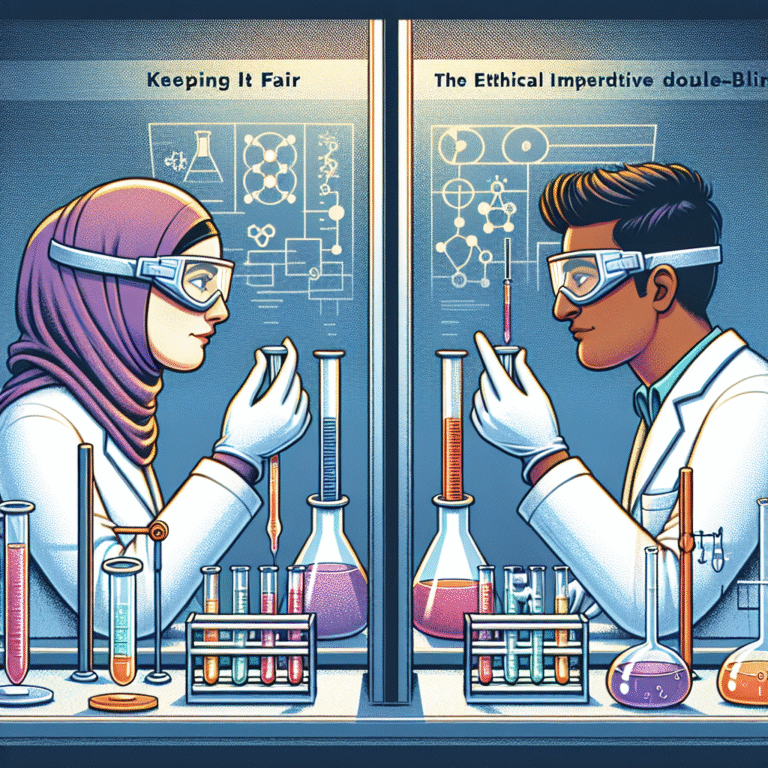
Introduction
In the ever-evolving landscape of scientific inquiry, the integrity of research findings plays a pivotal role in shaping policies, informing clinical practices, and driving societal change. Yet, a hidden danger lurks in the depths of our cognitive processes: unconscious bias. This phenomenon, often referred to as "ethical blind spots," can skew research results and undermine their validity. In this article, we will explore the implications of ethical blind spots, provide unique insights into recognizing and addressing unconscious bias, and ultimately champion a more equitable future for research.
Understanding Ethical Blind Spots
What Are Ethical Blind Spots?
Ethical blind spots are the cognitive biases that prevent individuals and groups from recognizing unethical behaviors or decisions in their own actions. These blind spots are particularly pronounced in research contexts, where preconceived notions about race, gender, socioeconomic status, and more can color the interpretation of data.
The Science Behind Unconscious Bias
Research indicates that the human brain employs heuristics—mental shortcuts to make decisions quickly. While these heuristics can be efficient, they also lead to biases that can cloud judgment. For instance, studies highlight that people often unconsciously prefer results that align with their beliefs or the norms of their social environment. Understanding the science behind these biases is critical in mitigating their influence.
Case Studies Illustrating Ethical Blind Spots
Case Study 1: Gender Bias in Clinical Trials
In a landmark study published in The Journal of the American Medical Association (JAMA), researchers found that less than 30% of clinical trial participants were women. This oversight not only skews the data but also puts women’s health at risk, as treatments may not be adequately tested for half the population.
Analysis
This case underlines the ethical blind spot of gender bias in research design. By failing to include diverse populations, researchers risk perpetuating systemic disparities in healthcare, emphasizing the need for diverse representation in all fields of study.
Case Study 2: Racial Bias in Predictive Policing
Another compelling example is the use of algorithms in policing, notably in predictive policing models that have come under scrutiny for perpetuating racial bias. Research has revealed that these models disproportionately target minority neighborhoods, leading to increased policing of those communities.
Analysis
The relevance of this case extends beyond just law enforcement; it raises questions about how data interpretation and model-building can reflect societal biases, often missing the ethical implications involved.
Recognizing Ethical Blind Spots
Self-Reflection and Education
The first step in addressing ethical blind spots is self-reflection. By encouraging researchers to evaluate their own biases through training programs focusing on diversity and inclusion, the field can foster a more conscious approach to research.
| Training Component | Benefits |
|---|---|
| Workshops on Implicit Bias | Raises awareness of unconscious biases among researchers |
| Diversity Training | Promotes a more inclusive research culture |
| Ethical Decision-Making Scenarios | Engages researchers in critical thinking |
Peer Review and Accountability
The peer review process is vital in mitigating bias. Encouraging diverse peer reviewers can provide additional perspectives, thus diminishing the potential for blind spots. Accountability in research and publication processes also helps enforce ethical standards.
Addressing Unconscious Bias in Research
Implementing Diverse Research Teams
Creating diverse research teams can lead to richer insights and varied perspectives. When individuals from different backgrounds collaborate, it minimizes the risk of homogenous thinking and encourages innovative approaches.
Utilizing Technology
Advancements in AI and machine learning can assist in identifying potential bias in research methodologies and data interpretation. These technologies can flag discrepancies that might go unnoticed, prompting researchers to reconsider their findings.
Building an Ethical Research Framework
Establish Guidelines for Ethical Conduct
Institutions must establish clear guidelines detailing best practices for ethical research. These guidelines should emphasize inclusivity and sensitivity toward bias, ensuring that researchers are equipped to recognize and address ethical blind spots.
Foster a Culture of Ethics
A culture promoting ethical conduct and awareness is essential. This can be achieved through regular seminars that invite open discussion about biases and ethical considerations in research.
Conclusion
In grappling with ethical blind spots, researchers have an opportunity to drive significant change in the world of science. By recognizing and proactively addressing unconscious bias, we pave the way for a more inclusive, valid, and trustworthy research environment. As we strive for excellence in research, let’s champion the cause of equity and integrity, ensuring that future discoveries reflect the diversity of the human experience.
FAQs
1. What are ethical blind spots in research?
Ethical blind spots refer to unconscious biases that impact the decision-making processes of researchers, often leading to skewed results.
2. How can we recognize unconscious bias?
Self-reflection, training on diversity and inclusion, and fostering open discussions about biases are effective ways to recognize unconscious bias.
3. Why is diverse representation important in research?
Diverse representation helps ensure that research findings are valid and applicable to a broader population, ultimately improving health outcomes and social justice.
4. How can technology aid in addressing bias?
AI and machine learning can analyze data for potential biases and inconsistencies, prompting researchers to critically evaluate their methodologies.
5. What are some actionable insights for researchers?
Researchers can take action by forming diverse teams, participating in continual education about biases, and adhering to established ethical guidelines.
By illuminating the complexities surrounding ethical blind spots, we can empower a new generation of researchers committed to ethical integrity and social responsibility in their work.















